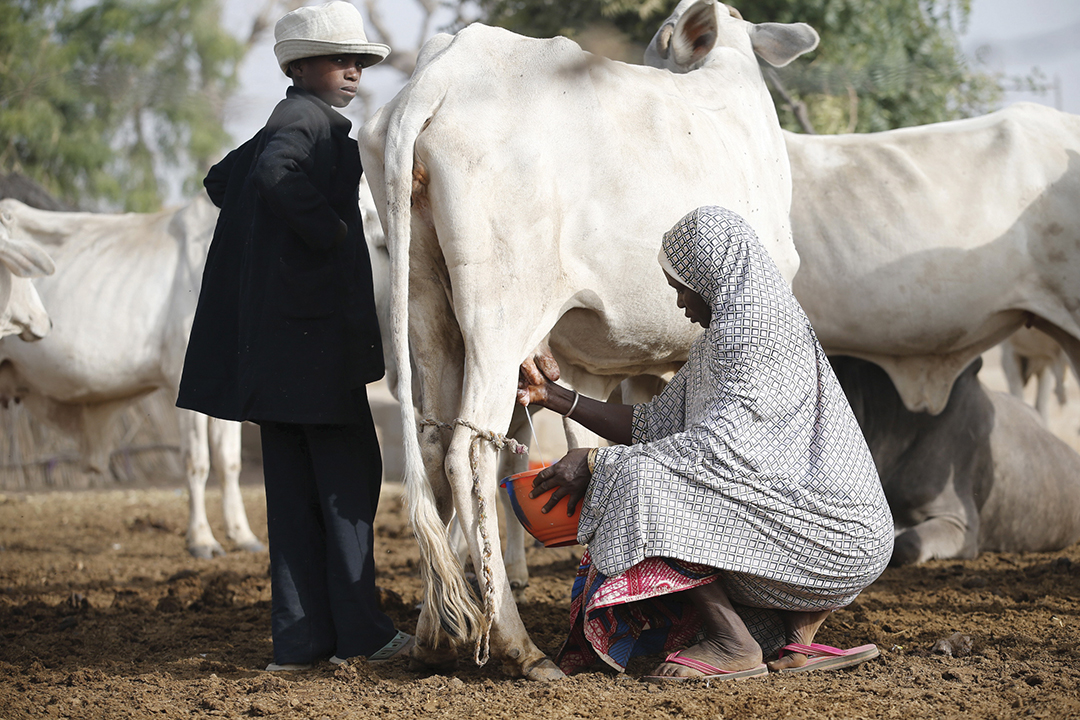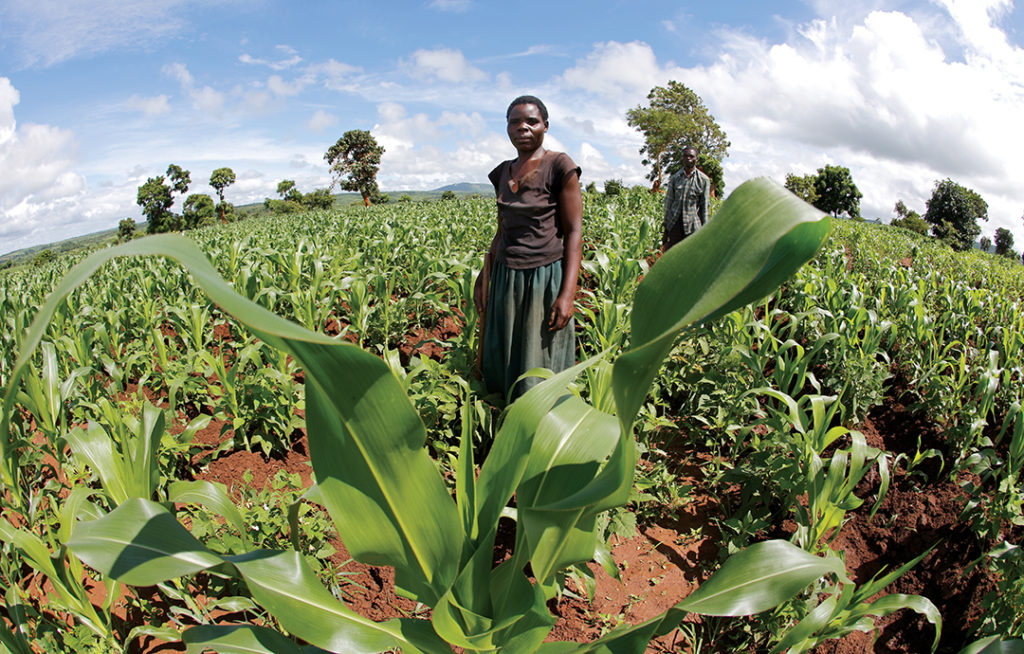Attacks by insurgent groups demonstrate the links between conflict and food security.
ADF STAFF
The human toll of Boko Haram’s long insurgency against the people of northern Nigeria is well-documented: Thousands have been killed, millions displaced and fear has rippled across the region.
But in addition to the lives they destroyed, the extremist group has had another target: the agricultural sector. Boko Haram’s attacks on farmers and their land have been relentless. The group’s presence has cleared out much of the northeastern part of the country and transformed what once was known as Nigeria’s breadbasket into a food-insecure region. They’ve also targeted farms directly, burning crops, killing livestock and destroying infrastructure.
Boko Haram offers a case study in the ways that conflict and food security are linked. Understanding this link is vital for security professionals looking for ways to protect civilians from the secondary effects of war such as famine, disease and displacement. These effects, which fall under the category of “human security,” are historically much deadlier than the conflicts themselves.

Ernest Ogbozor, a native of Kaduna in northeast Nigeria, is a former Red Cross worker who is now a Ph.D. candidate at George Mason University’s School for Conflict Analysis and Resolution. Since 2010 he has interviewed farmers in Cameroon, Chad and Nigeria to determine the impact Boko Haram has had on their livelihoods.
He found that in order to control the population, the extremist group deliberately targets the food supply in nefarious acts he calls “asset stripping.”
“If they cannot kill you, they take out your livelihood means. They burn everything,” he told ADF. “It means that even if you are alive, you won’t have anything to live on.”
About 80 percent of the people who live in rural Nigeria are farmers. Their primary crops are sorghum, millet, groundnuts, beans and rice. In 2013, when Boko Haram took over most of Borno State in northeast Nigeria, many farmers fled, and the extremist group began systematically burning crops and destroying infrastructure. As of early 2016, Boko Haram had destroyed 1,630 water sources used for irrigation including motorized boreholes, hand pumps and solar-powered pumps, according to the World Bank. Farmers who stayed behind were forced to pay Boko Haram taxes ranging from 1 million to 3 million naira ($6,000 to $18,000) in exchange for safety.
“They wanted to make an impact, to show that they are in charge,” Ogbozor said of the terror group.
The impact on the area’s food supply was devastating and wide-ranging. IRIN found that as farmers missed multiple planting and harvesting seasons, food became scarce, and the price of staples such as beans and onions rose by 70 percent. Additionally, because Boko Haram uses fertilizer as a component of bombs, the government restricted access to the product, adding another hardship for farmers, Ogbozor said.

The commercial activity of buying and selling food ground to a halt. The Baga Fish Market in Maiduguri, an economic engine that served the region, was attacked 20 times between 2009 and 2015, forcing nearly all vendors to flee. A cattle market in Adamawa, which drew herders from surrounding countries, was shut down after a suicide bomb attack in 2015. Another large cattle market in Maiduguri was shut by the Nigerian military for fear that Boko Haram was profiting from sales there.
Boko Haram also attacked pastoralists. The group stole or killed 470,000 head of livestock in Borno State, according to the Nigerian newspaper Daily Trust. The depletion of cattle herds caused the price of meat to nearly triple in some areas, Reuters reported.
When interviewing farmers in the largest camps of internally displaced people in Borno State, Yobe State and in Adamawa State, Ogbozor was struck that people accustomed to being self-sufficient had become dependent. Tailors and cobblers could start businesses in the camps, he said, but farmers without access to land were forced to sit idle.
“A lot of them are dependent on handouts, on emergency relief,” Ogbozor said. “Some of them lost family members, and they’re just trying to cope. Some don’t know what the future will be if they return.”
The attacks have taken a toll, not just on the farmers’ livelihoods, but also on their sense of self-worth.
“We cannot afford to buy food from the market, and we [now must] depend on the kindness of strangers to survive,” Mohamed Ali, a farmer from Adamawa, told IRIN. “I was the breadwinner. Now I have become a beggar.”
Conflict leads to food insecurity
When farmers are forced off their land and the road networks and supply chains that move food to consumers are disrupted, people suffer. A study by the International Food Policy Research Institute (IFPRI) examined 14 countries prone to violence and found a median drop in food production of 12.3 percent during times of conflict.
Furthermore, conflict triggers large-scale migrations and transforms self-sufficient families into refugees. When northern Mali fell to extremists and separatists in 2012, it forced an estimated 400,000 Malians, many of whom had been farmers or herders, to flee their homes. This not only disrupted food production in northern Mali — grain prices rose by 80 percent to 100 percent there in 2012 — but it placed a major strain on host communities in Burkina Faso, Mauritania, Niger and Senegal. Aid agencies historically have met the food needs of refugees and the impact is not all negative for host communities, but the influx of people disrupts the economy and can result in a xenophobic backlash.
“Most refugees are hosted in neighboring countries that do not necessarily face better economic conditions and often have pre-existing food insecurity,” scholars wrote in a paper published by IFPRI titled “Refugees, Food Security, and Resilience in Host Communities.” “This may place a further burden on hosting populations and may erode their resilience to withstand shocks and achieve food security over time.”

Conflict can drive food insecurity in other ways. Young male laborers are essential to farm work but also are the first ones to be conscripted into national militaries during times of war or to be targeted by homegrown insurgents. This weakening of the labor pool further aggravates food insecurity.
“The people most likely to participate in armed conflict — young men from rural areas with limited education and economic prospects — are likely to seek work in the agricultural sector,” Henk-Jan Brinkman and Cullen Hendrix wrote in a 2011 report for the World Food Programme. “As that work dries up, fighting looks more attractive.”
Food insecurity causes conflict
Just as violence can cause food shortages, food shortages can lead to violence. In 2008, the price of grains including rice, wheat and corn rose sharply across global markets. The wealthy barely noticed the price increase, but it marked a breaking point for many people living in poverty who took to the streets to voice their resentment. People protested and rioted in 48 countries, including Mozambique, where rioters clashed with police, and Haiti, where officials ousted the prime minister after a week of demonstrations.
Food prices are rarely the only grievance, but they can spark the fire of popular resentment. One of the largest demonstrations in modern African history was the three-day bread riot in Egypt in 1977, which led to the deaths of more than 800 people. “Spiking food prices may provide an incentive for people to give voice to underlying grievances on other conditions that affect their food security — for example, jobs, incomes, or government policies,” wrote Emmy Simmons in a report for the Woodrow Wilson Center. “Where there has been a failure of governance, such as in Somalia, recurrent food scarcity and famine become part of a vicious cycle of instability, with food insecurity both resulting from and contributing to repeated rounds of armed conflict.”
Similarly, when access to land for cultivation or livestock grazing is limited, conflict ensues. Across the Sahel region, sporadic rainfall and an encroaching desert are forcing nomadic pastoralists to move farther and farther afield in search of grazing land. This movement puts them into direct conflict with farmers who till the land.
This competition for scarce resources has led to violent clashes among ethnic Fulani herders and farmers in Nigeria, Bambara farmers and Peul herders in Mali, and the farming Pokomo people and cattle herding Orma people in Kenya. According to SBM intelligence, there have been 371 clashes between herdsmen and farming communities in Nigeria alone since 2011. The attacks between the heavily armed groups cost the country about $14 billion annually, the group found.
Food as a weapon of war
One of the most effective and reprehensible ways to control civilians is by interrupting their food supply. Throughout history, governments, militaries and rebel groups have used food as a way to reward loyal peasants and punish those who rebel. Researcher Alex de Waal studied efforts by Sudanese Janjaweed militants to control Darfuri populations in the early 2000s by destroying farms and livestock. He called it “counter-insurgency on the cheap,” adding that “famine and scorched earth [became] their weapons of choice.”
In the mid-1990s, researcher Ellen Messer coined the term “food wars” to describe this tactic. In her studies she found that militants were using this type of food control in 18 African countries at that time.
“Adversaries starve opponents into submission by seizing or destroying food stocks, livestock, or other assets in rural areas and by cutting off sources of food or livelihood, including destruction of markets,” Mosser wrote. “Land and water resources are mined or contaminated, to force people to leave and to discourage their return.”
What can be done?
Several strategies and tools have proved effective at improving food security and decreasing violence in countries prone to conflict and food shortages.
• Early warning networks: Such systems compile information about food prices, food availability and agricultural conditions from a wide variety of sources so that government agencies can anticipate food shortages and price shocks.
• Price interventions: Many countries subsidize some staple goods to prevent large price fluctuations for farmers and consumers. However, careful economic policy is required. Poorly applied subsidies can distort markets in harmful ways or become financially unsustainable in the long term, leading to greater conflict once they’re removed.
• Build resilience: Strategies for resilience include diversifying and rotating crops, modernizing cultivation practices, adding ancillary farming businesses, and organizing co-ops to help farmers prepare for lean years.
• Shared management: Pilot projects in Ethiopia, where interethnic and intercommunal violence over land resources was common, have shown success. These projects demonstrated that when communities that had been adversaries partner to manage land and make shared decisions about natural resources, there is less violence.
• Protecting farmers: Experience in numerous countries shows that farmers are among the most vulnerable members of society to attacks by insurgent groups. An understanding of the important role farmers and herders play in bolstering human security should cause militaries to place a higher priority on protecting them.

